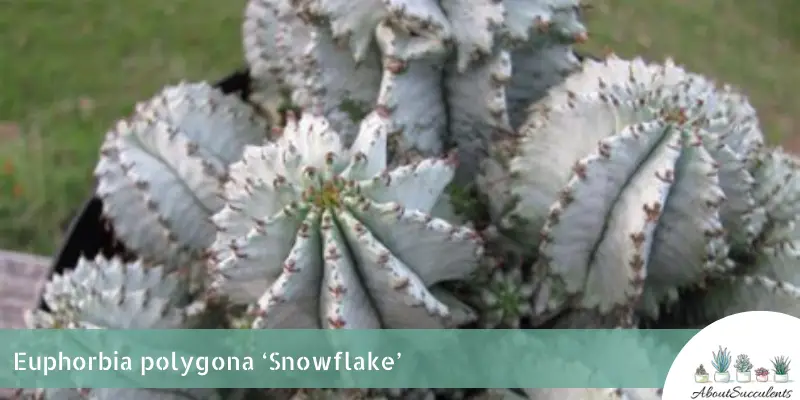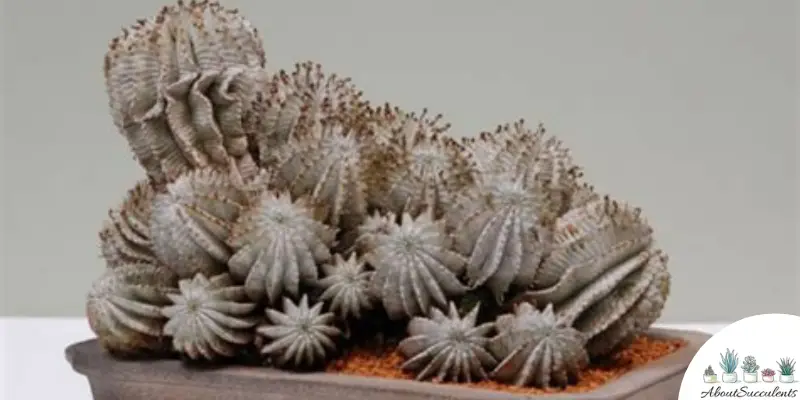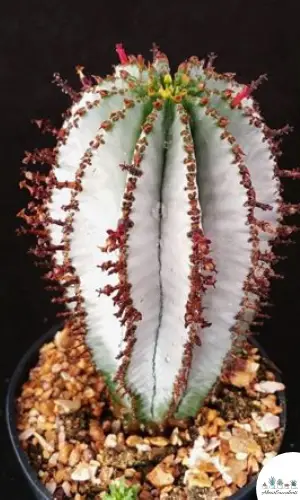
Euphorbia Polygona, also known as ‘Snowflake’ is an eye-catching evergreen succulent that forms densely packed columns of white with hints of green cylindrical stems.
The stems are deeply ribbed with serrated edges covered with sharp brown spines. Snowflake is a fast-growing succulent that bears dense colonies of offsets around the base of the plant.
The winter dormant plant can grow up to 30cm – 60cm (12” – 24”) tall and 15cm – 30cm (6” – 12”) wide.
Euphorbia Polygona gets beautifully crowned with purple-red flowers during late spring or summer. Snowflake also produces small round fruits covered with grey hairs that grow up to 0.5cm ( 0.2”) in diameter.
Euphorbia Polygona originates from the Eastern Cape province in South Africa. Snowflake belongs to the Euphorbia genus from the Euphorbiaceae family.
General Information
Also known as: Snowflake
Plant Family: Euphorbiaceae
Origin: Eastern Cape province in South Africa
Height: 30 cm – 60 cm (12” – 24”)
Exposure: Full to Partial Sun
Water needs: Use the ‘soak and dry’ watering method; give the soil a good soaking then water again only when the soil has gone stone dry.
Soil Type: 50% cactus or succulent soil and 50% combination of perlite, coarse sand, and pumice
Soil pH: 6.0 to 7.4
How to Grow and Care for Euphorbia Polygona

Euphorbia Polygona is easy to grow and care for. This majestic-looking succulent requires a little doting at its early stages of growth but once established, it can thrive with little attention.
Many succulent growers add Snowflake to their outdoor rock or Mediterranean gardens. Its unique appearance perfectly complements centerpiece arrangements for indoor container gardens.
Euphorbia Polygona is not cold-hardy and cannot tolerate temperatures below -3.9°C (25°F).
If you live in regions where temperatures are less than ideal for a succulent named ‘Snowflake’, it would be recommended to plant Euphorbia Polygona in a movable pot.
Sunlight
Euphorbia Polygona requires plenty of sunlight exposure to grow well. If you will plant it outdoors, choose an area where it can get at least 6 hours of full to partial sun.
Indoors, place your container near the south, southeast, or southwest-facing window. Keep in mind that if your Euphorbia ‘Snowflake’ does not get ample lighting, the stems will stretch out in search of a light source.
Get a phyto lamp if you do not have a sunny area in your house. This lamp mimics natural lighting suitable for growing indoor plants.
Watering

Euphorbia Polygona cannot survive long periods of drought. You need to water it regularly but avoid letting it sit in overly damp soil for more than 3 days to prevent root rot.
Use the ‘soak and dry’ watering method. Water your plant once a week during spring and summer. Soak the soil deeply until excess water flows out of the drainage hole. This will allow the roots to take in enough water to last them a week.
Make sure that the soil has dried out completely between waterings. To test if the soil is dry enough to be watered again, insert a stick into the soil. If it comes out dry, you can water the soil. Refrain from
Euphorbia ‘Snowflake’ requires very little water during winter when it becomes dormant.
Pot and Soil
Succulents grow well in terracotta or ceramic containers. These pots are made with breathable materials that allow the soil to dry quicker. Choose pots that have drainage holes to prevent waterlogging.
Euphorbia ‘Snowflake’ prefers fast-draining soil. Your potting or garden soil mix should contain 50% cactus or succulent soil and a 50% combination of perlite, coarse sand, and pumice. Adding mineral grit will improve drainage and soil aeration.
To boost its growth during spring and summer, add organic matter or fertilizer to your garden bed. If potted indoors, feed your plant with half-strength succulent fertilizer.
How to Propagate Euphorbia Polygona
Euphorbia Polygona can be propagated by using its offsets and stem cuttings. The best time to propagate is in early summer.
You need to be extra careful in handling Euphorbia ‘Snowflake’ when you are propagating because the white sap can cause moderate to severe skin irritations. Wear gloves when you are handling the plant.
Method 1 – Offsets
Step 1: Select small offsets around the base of the plant.
Step 2: Use tongs to gently twist and pull the offsets away from the cluster. If you cannot pull them out, use a sterile sharp knife to cut them off.
Step 3: Place the offsets on a dry area and allow them to callous over a few days.
Step 4: Plant the offsets in a terracotta pot filled with a cactus mix, perlite, pumice, and coarse sand. Wait a week before watering the soil.
Method 2 – Stem Cuttings
Step 1: Use a sterile sharp knife or pruning shears to cut stems at the base of the mother plant.
Step 2: Leave the stem cuttings in a warm area for 2-3 days to allow the wounds to callous over.
Step 3: Plant the stem cuttings in terracotta pots filled with cactus mix and mineral grit. Before you plant the cuttings, you can dip them in a rooting hormone to accelerate root growth.
Step 4: Place the pots in a well-ventilated and warm area. Mist the soil every few days. Your cuttings will develop roots after a few weeks.
Frequently Asked Questions
Is Euphorbia Polygona Toxic to Cats and Dogs?
Euphorbia Polygona is not included in the list of plants toxic to cats and dogs on the website of the American Society for the Prevention of Cruelty to Animals (ASPCA).
However, this is only a partial list.
The milky sap called latex of the Euphorbia genus is toxic. It can cause severe skin and eye irritations. Place your Euphorbia ‘Snowflake’ out of reach of your pets.
Why is My Euphorbia Polygona Dying?
If your Euphorbia Polygona is becoming less vibrant, it could be suffering from an illness caused by the following:
Overwatering
Overwatered Euphorbia Polygona can still be revived for as long as you treat it before the fungal infection spreads from the roots to the other parts of the plant.
Remove your plant from the garden bed or pot. Shake off the soil from the roots. Examine your plant carefully. Cut out all the mushy and blackened parts with a sterile sharp knife or pruning shears.
Leave your plant in a well-ventilated and partially shaded area. Allow it to dry out for three to five days.
Replant your Euphorbia ‘Snowflake’ in its garden bed or in a terracotta pot filled with cactus mix and mineral grit. Wait a week before you water the soil.
Pest Infestation
Mealybugs and aphids love to feast on Euphorbia Polygona. These sap-sucking pests can be removed by spraying your plant with 75% rubbing alcohol or soapy water (few drops of dishwashing soap in 2 cups of water).
Repeat the treatment once a week until you get rid of all the pests. Make sure to quarantine your infected plant during treatment.
Yes, Euphorbia Polygona blooms purple-red flowers during late spring or summer.
Last Updated on June 9, 2022 by Sofia Lara